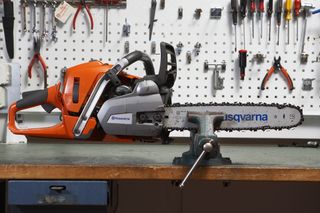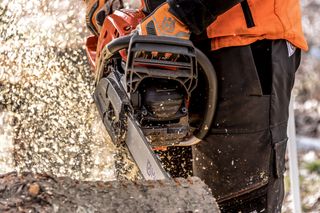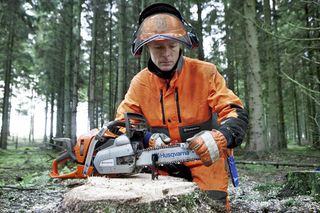
Garden Tool Storage Hints, Tips & Tricks
Correctly storing your garden tools goes a long way to maximising their product life and minimising maintenance, helping you get more out of them over the years. Of course, the way you store your tools will depend on what they are and what types of storage spaces you have available. For this article, we'll focus our attention on petrol and battery-powered garden tools such as lawn mowers, hedge trimmers, chainsaws, and blowers - but these tips can be applied across the board. Once you've nailed it the first time, it'll become much easier to store your garden power tools like a pro.
Can Garden Tools Be Stored Outside?
Forgetting to bring tools back inside after use is easy to do, but it could end up costing you in the long term. Garden tools such as lawn mowers, hedge trimmers, chainsaws, leaf blowers and grass trimmers have moisture-sensitive components that can get damaged by extended exposure to rain, humidity and damp conditions. Leaving them out by accident every now and then won't damage them, but leaving them out for long periods could. To enjoy the longest shelf life and best output, keeping your tools well protected and undercover is the way to go.
The Best Place to Store Garden Tools
When it comes to the best place to store your gardening power tools, some spots are better than others. Anywhere that is dry, warm and protected from the elements will always be a better option than leaving them outdoors or in a damp environment. To give you an idea, here is a short list of places people have stored their tools - From best to worst:
- Heated garage (best option)
- Garden shed (good second runner up)
- Utility room (without washer/dryer)
- Storage container (waterproof and airtight)
- Under tarpaulins (last resort)
- Uncovered outdoors (not a good idea)
Storing Li-ion Batteries
Before storing any battery powered garden tools, the first thing you want to do is remove the battery from the machine. It not only prevents energy from being leached out over time but also minimises the risk of any corrosion or damage to your tools. If your battery came with a protective case, it is a good idea to use it and put it away somewhere dry and out of direct sunlight. If you don't have a battery case, wipe it down with a dry cloth to remove moisture, then wrap it in a micro-fibre cloth and place it into a box for safe storage.
Top Tips for Creating a Dry Environment
Cleaning and storing your tools correctly is the way to go when looking for long-lasting reliable tools. A dry environment will always be the best option as the air lacks moisture, humidity and mould spores. However, we wish we all had a heated garage or utility room available for storage. So for the rest of us, the priority is to find somewhere protected from the rain and wind with as little dampness and humidity as we can.
If you are using an unheated garage, a covered lean-to, or a garden shed, the first thing you'll want to do is ensure there are no leaks in the roof or walls. A silicone or foam-based filler and sealant is the quickest way to fix any cracks or holes. If you have access to a power outlet in your storage area, a dehumidifier will draw any moisture out of the air, preventing damp and mould from setting in.
During the coldest months, a heater will go a long way with keeping the space dry too. A basic fan heater on a timer is a great option but can run up higher energy bills. Paraffin greenhouse heaters also work very well for raising the temperature and preventing mould and dampness. Lastly, ensure that there is adequate airflow in the area. The more air that can circulate, the less moisture will settle on your tools.
Tool Prep in Two Steps
Before storing any tools, it's always a good idea to prepare them for storage - especially over the autumn and winter months. Dirt, grime and moisture can lead to the formation of rust and deterioration, so a bit of prep upfront will help keep them in tip-top condition come spring and summer.
Cleaning
- If you have battery-powered tools, remove the battery before you clean.
- Start by wiping down the chassis of your tools with a damp cloth. Warm, soapy water works best and helps get rid of any dried-on dirt and grass. Wipe dry with a soft, dry cloth afterwards.
- For chains, knives and metal parts, an old, dry toothbrush will get into any corners and crevices, removing any grime.
- Avoid using solvents or saturating your tools when cleaning them. If you're unsure which chemicals to avoid, check your tools user manual. Search for your tool user manual here
Sharpening
- Using a file, sharpen your chainsaw chain, trimmer knives and mower blades to give them nice and sharp edges.
- Apply a light coating of mineral oil or your chosen chain oil to help prevent moisture from oxidising the metal over the winter.
- Place inside your tool storage box or carry case and put on a shelf or in a cupboard above ground level.
Keeping Things Tidy
Tools should also be stored off of the ground where possible. Wheeled tools will be fine on the ground as their wheels will elevate them above any potential pools of water and puddles.
For an economical option for bringing your tools off the ground, house bricks or breeze blocks with wooden boards placed on top of them work well. For other tools such as hedge trimmers, blowers, grass trimmers etc., you could add large hooks on your walls to hang them from - it doesn't look too bad either.
Most tools will come with a carry case or have them available to purchase separately, like our chainsaw carry case. These cases are designed to keep your garden tools safe and protected, keeping the moisture, damp and mould away. With batteries, charge them to around 50% and place them in a battery box or dry drawer inside your home.
At Husqvarna, we have many options available to help you safely store your garden power tools when not in use. By spending a little bit of time preparing them to be put away for the cooler months, you'll be able to enjoy sharp cuts and trouble-free starting come spring, and they'll keep performing well for you season after season.
For a guide on storing your garden tools over periods of non use or just more information on tool storage in general, check out our other blog: Top Tips For Storing Your Tools During Winter.










